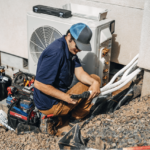For decades, India’s advanced medical care has been concentrated in major metros—Delhi, Mumbai, Chennai, Bengaluru. While these cities offer world-class heart hospitals and technology, the real challenge lies elsewhere. The majority of India’s population lives in Tier 2 and Tier 3 cities, where access to specialized cardiac care remains limited.
But things are changing. With the rise of Enhanced External Counter Pulsation (EECP) therapy, there is a new wave of non-invasive, affordable, and accessible heart care reaching beyond big cities. Clinics and hospitals are now expanding their services to smaller cities, where people often suffer in silence or travel long distances to seek treatment.
This blog explores how EECP treatment in India is bridging the cardiac care gap, especially for those in underserved towns and rural regions. It also highlights how this therapy is transforming lives—quietly, affordably, and without surgery.
The Urban-Rural Divide in Cardiac Healthcare
India’s heart disease burden is no longer limited to urban populations. Today, even smaller towns are witnessing a rise in:
- Hypertension
- Obesity
- Diabetes
- Sedentary lifestyles
Unfortunately, access to advanced treatments like bypass surgery or angioplasty is often out of reach due to:
- Lack of infrastructure
- High cost
- Limited awareness
- Long travel times to metro hospitals
This is where EECP comes in as a practical solution—a non-invasive therapy that requires no hospitalization, minimal setup, and yet delivers results.
What is EECP?
EECP (Enhanced External Counter Pulsation) is a non-surgical heart therapy designed to improve blood circulation. The treatment involves:
- Placing inflatable cuffs around the patient’s legs and thighs
- Synchronizing the inflation and deflation with the heartbeat
- Enhancing oxygen-rich blood flow to the heart and vital organs
EECP is safe, cost-effective, and usually completed over 35 sessions, each lasting about an hour. It’s suitable for patients with angina, fatigue, poor circulation, or even those looking for preventive heart care.
Why EECP is Ideal for Tier 2 and Tier 3 Cities
1. No Need for Expensive Surgical Infrastructure
Unlike angioplasty or bypass surgery, EECP doesn’t require an operation theatre, surgical staff, or intensive post-op care. A small clinic with trained technicians and a modern EECP machine is enough to deliver effective therapy.
2. Perfect for Patients Who Can’t Travel
Traveling to big cities for surgery means additional costs—travel, accommodation, time away from work, and emotional stress. EECP available locally makes it easier for patients to complete treatment in their own city, with family support and minimum disruption.
3. Safer for High-Risk or Elderly Patients
Many patients in smaller towns suffer from co-existing conditions like diabetes or kidney problems. These make surgery risky. EECP offers a safe, non-invasive alternative without the complications associated with surgery.
4. Affordable for Middle-Class and Rural Families
A full EECP treatment cycle in India usually costs between ₹80,000 to ₹1,50,000—much lower than surgery or stent procedures. With low setup costs, local clinics in Tier 2 and Tier 3 cities can pass on the cost benefits to patients.
5. Minimal Manpower and Maintenance
EECP is easy to administer. After proper training, clinics can operate the system with a small team. This allows expansion even in towns with fewer medical professionals, making heart care more available where it’s most needed.
How EECP is Expanding Across India
Thanks to healthcare innovators and heart-focused startups, EECP treatment in India is no longer confined to metros. Clinics like Nexin Health are now reaching smaller cities with:
- Satellite centers
- Mobile consultation teams
- Telemedicine-enabled follow-ups
- Franchise-based EECP centers for deeper outreach
This decentralization means better coverage for cardiac patients who were once left behind.
Success Stories from Tier 2 and Tier 3 Cities
- In Madurai, a retired school teacher suffering from chronic angina avoided surgery and resumed his daily walking routine after 35 EECP sessions.
- In Nashik, a diabetic patient unfit for bypass saw remarkable improvement in circulation and energy levels post-EECP.
- In Raipur, a homemaker with borderline blockage completed preventive EECP therapy after routine stress test abnormalities were discovered.
These stories are becoming more common, as awareness spreads and clinics invest in non-invasive cardiac care across India.
EECP: A Preventive Approach in Smaller Cities
Preventive cardiology is still growing in non-metro regions. Many people don’t seek help until symptoms become severe. EECP is helping change that. By offering a low-risk and accessible option, more people are seeking care earlier—before blockages, surgeries, and hospital emergencies occur.
EECP encourages regular heart screening and timely intervention, reducing the long-term burden on both patients and hospitals.
Role of Digital Healthcare in Supporting EECP Expansion
Telemedicine platforms and digital health apps are now playing a role in supporting EECP in smaller cities. Clinics can:
- Monitor vitals remotely
- Provide post-treatment guidance via video calls
- Share test reports through cloud systems
- Encourage follow-ups without the need for travel
This hybrid approach combines local access with global-quality care.
The Way Forward: Making EECP Mainstream Across India
To truly make EECP a national movement, we need:
- More awareness campaigns in regional languages
- Training programs for rural healthcare providers
- Financial partnerships or insurance integration
- Government-led cardiac wellness schemes with EECP inclusion
With the right support, EECP can become a standard heart care solution across India, not just in big cities.
Conclusion
India’s cardiac care landscape is evolving—and EECP is at the center of this change. Its ability to deliver results without the need for surgery makes it a perfect fit for Tier 2 and Tier 3 cities. As healthcare shifts toward non-invasive and preventive models, EECP will play a vital role in reaching India’s heart patients where they are—affordably and effectively.
Frequently Asked Questions (FAQs)
1. Is EECP available in Tier 2 or Tier 3 cities in India?
Yes. EECP is now offered in many Tier 2 and Tier 3 cities through expanding networks like Nexin Health. Availability is growing rapidly as clinics realize the need for non-invasive heart care across the country.
2. How much does EECP treatment cost in smaller towns?
In smaller cities, EECP treatment usually costs between ₹80,000 to ₹1,20,000 for a full 35-session cycle. This cost is often lower than in metro cities due to reduced operational overhead.
3. Can I get the same quality of EECP in a smaller city as in metros?
Absolutely. EECP machines used across India are certified and follow international standards. Clinics like Nexin Health offer uniform quality, trained staff, and proper protocols regardless of the location.
4. What if there are no EECP centers near my city?
Many centers are now expanding via franchise models and partnerships. You can contact a provider like Nexin Health to locate the nearest center or request a new center in your area.
5. Is EECP safe for older patients in rural areas?
Yes. EECP is especially suitable for elderly or high-risk patients. It is non-surgical, painless, and doesn’t require hospitalization. Many patients from rural areas complete treatment without any complications.



